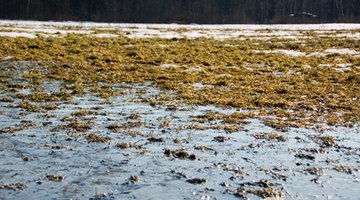How to Dig a Water Spring
If you have an area of your lawn that seems to hold water or seems to stay soggy, you may have a spring on your property. Digging your spring water source up may give you an added water source.

Things You Will Need
- Brightly colored stakes or flags
- Shovel
- Pick axe
- Rock bar
Tip
If you are considering using the spring water, make sure to have it tested to certain it is okay for human consumption. You may choose to cover your spring water with plywood, boards or even a plastic cover to avoid runoff and debris.
The main part of digging a water spring is that it is labor intensive, but if you indeed have a spring, it can make a nice addition to your yard and possibly give you a water source for various household tasks.
-
Mark off the area that you think may be a natural spring. Use brightly colored stakes or flags to set the area off. The types of area you are looking for are those that remain wet even when there has been no rain or areas that seep water during wet seasons.
-
Dig out the area that you have marked. Use the shovel to begin digging around the perimeter and then move into the center of the area. Make sure to throw your dirt into one area outside of the area marked as your possible spring. You will need this dirt later on.
-
Remove any rocks, roots, or other debris with a pick axe and rock bar. Save the rocks in a pile outside your spring source as you will be using them later.
-
Dig deeper until you get a good flow of water. From the hole that you are digging, dig a trench that leads out from where the water is coming up to the side of the hole.The trench will move the water from the spring to the sides of the hole. This keeps the water moving down through out the rest of the hole instead of just coming up and pooling around the original entry site. Dig the trench as deep as possible as the deeper your trench is, the cleaner your water will be. If you do not dig a trench, the water will not flow and instead will become stagnant. The trench helps the water to move throughout the hole. Not only is this not clean, but it will allow mosquitoes to breed.
-
Line the area around the spring hole with the rocks you have removed. The rocks keep falling dirt from going into the hole.
-
Place the dirt that you removed around the spring water hole. This will keep water from running off from other sources into your spring. Groundwater runoff can cause your water to be dirty and possibly clogged with debris.
References
Writer Bio
Melanie Fleury has been writing professionally since 1995. She has written for various educational websites such as Edhelper.com and is the educational consultant at the Knowledge Tree Center for Education. She enjoys creating curriculum for children with various learning styles. Fleury holds a master's degree in education specializing in early childhood from Ashwood University.
Photo Credits
- high water in the field, flood in the spring image by Daria Miroshnikova from Fotolia.com
- high water in the field, flood in the spring image by Daria Miroshnikova from Fotolia.com
More Articles



